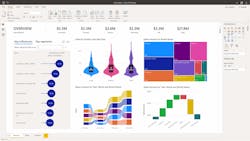Understanding Analytics Software for Industry
For years now, analytics software has held the promise of identifying where production can be improved, costs can be cut, and downtime avoided. And now, as industry adapts in real time to supply chain threats due to the COVID-19 pandemic, along with reduced consumption of some goods and increases in others, analytics software is quickly moving from a nice-to-have technology for higher level business decision making to a must-have technology for assessing operational flexibility.
Automation World recently had the opportunity to connect with Matt Boese, vice president of the Digital Advisory Team at Columbus Global, to get a better understanding of how industrial companies should be thinking about analytics software today. Columbus Global is a technology service and consulting business helping companies modernize their operations digitally. The entire discussion can be heard in the podcast, “How to a Quick ROI from Analytics Software.”
“A good starting point [when it comes to assessing analytics software] would be to define what we mean by analytics and analytic software,” said Boese. “[Since] analytics is really about using data to answer questions and solve problems, the first step is to have a road map for what you want to accomplish. What information would be useful to help make decisions and improve your business. Then you can begin thinking about how to deliver that information and how to prove the quality of it.”
Boese noted that, even with advanced analytics software, getting good analytics results depends on having captured quality data in the first place. “It's just like that old adage, garbage in garbage out,” he said. “So, for that reason, it's really important that there's an overlap or coordination between the systems that capture the data and the analytical systems that you’re using to get the data out."
Columbus Global prefers the Microsoft tool set, such as Microsoft Dynamics 365 and the Microsoft Power Platform, because these systems are aware of one another and are built to work together, Boese said. Using these tools “makes it a natural fit for teams working on the systems of record to support the analytics team,” he said. “And it's important to ensure that we're managing our business processes in a way that supports capturing the data required to answer the questions we want to solve with analytics. That’s why there needs to be a fluid relationship between the teams that are working on capturing the data in your ERP (enterprise resource planning) system or your CRM (customer relationship management) system and the analytics team.”
Applying analytics
Explaining where analytics software can have the most impact for a manufacturer in the short term, Boese pointed to quality operations.
“By looking at historical patterns and data sets, we can find the combination of circumstances that would likely lead to a quality problem or a non-conformance,” Boese said. “That way, we can not only work to eliminate the root causes, but we can get alerts that a particular production order is at a higher risk than average. [With that information] we can take action to reduce the number of rejected finished products, minimize rework, and lower the cost of quality.”
Another example Boese offered deals with applying analytics to identify factors contributing to delays in production and shipping. With analytics, companies can identify the common denominators on orders that experience shipping delays and then look for patterns across those factors to understand the confluence of events that contributed to the delays.
Manufacturers and processors can also use analytics to examine the patterns and markers of sales opportunities “that are headed in the right direction to help predict which sales opportunities are actually likely to close and which ones are not such great opportunities after all,” Boese said.
“Another application is using advanced statistical and analytical tools to help with demand forecasting, which results in improved scheduling and materials planning,” he added.
Analytics software can also be applied to human resource issues as well. “It's easy to know all of the signs of an unhappy employee or the factors that might contribute to employees becoming unhappy with their job. Things like getting skipped over for a promotion, receiving a bad review, management turnover, multiple hard shifts in a row, all these things could contribute to an unhappy employee,” Boese said. “And while a manager might be aware of all of these factors in a general sense, the hard part in a busy production environment where a manager is overseeing a large team is finding that needle in the haystack—which particular employee is exhibiting the characteristics of an employee who might leave. That's where analytical tools that monitor the data landscape and pull together all the combined data can identify when a particular individual is hitting enough markers to warrant an alert to the manager.”
Return on investment
Since Boese’s responses often focused on the use of analytics by small to mid-sized manufacturers, I asked him if different size companies should be assessing analytics software differently. He responded by noting that Microsoft’s efforts to democratize analytics means they have made advanced analytics software—typically used by large companies—accessible to the mid-market.
“They're putting all the necessary tools in one environment in the Microsoft Cloud with a user-friendly interface and an ability to put together an end-to-end solution in one spot. They're even pre-building the algorithms that analyze the data. In the past, it would have been necessary to have a highly trained and highly paid data scientist to analyze this data and that person would have had to work alongside a highly skilled developer or team of developers working with a number of disparate applications and niche tools to pull all of this together and get a result. Microsoft is changing the game in this regard. They're giving us a set of statistical tools to do the analysis of the data, assign the cloud computing power to perform that analysis, and then take the output of the analysis and make it available for presentation in reports and dashboards. That's why you're hearing the term ‘citizen data scientist’, [because] Microsoft is making all of this now accessible to small and mid-sized businesses.”
Explaining the fast returns on investment that can be achieved with democratized analytics, Boese noted an example of a Columbus Global customer that produces almonds.
“They're using analytics to optimize the way they sort and select their almonds for packaging. And they've estimated that, by doing this, they're now saving one cent per pound on a production volume of 75 million pounds per year. That's an annual savings of $750,000.”
He added that this company, like most Columbus Global customers applying analytics to their operations, are achieving ROI in a matter of months, not years. “It is a very powerful return on investment, and probably one of the best investments companies can make,” he said.
About the Author
David Greenfield, editor in chief
Editor in Chief

Leaders relevant to this article:

